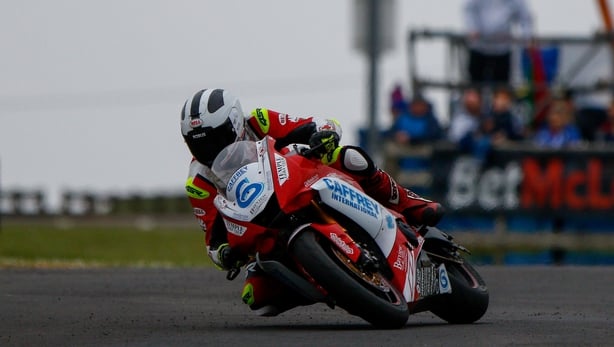A jury has returned a verdict of death by misadventure into a fatal motorcycle collision involving a leading figure in international motorsport, William Dunlop, during a road race in north Dublin five years ago.
The finding was made at the end of a three-day inquest at Dublin District Coroner's Court which heard that a garda investigation had concluded that the fatal crash involving the well-known Northern Ireland sports star was "nothing other than an accident."
Superintendent Edwards Carroll told the hearing that there was no suggestion of any criminality in relation to Mr Dunlop’s death.
However, an expert report commissioned by the deceased’s family, which found his motorcycle was "too low to the ground," was not admitted as evidence by the coroner, Dr Cróna Gallagher.
She said it seemed that suggestions made in the report that there might be something "inherently defective" with the vehicle would be more properly addressed in a different forum.
Supt Carroll said the evidence collected from many witnesses as part of a "lengthy and complex investigation" pointed to a mechanical failure of Mr Dunlop’s motorcycle after a sump plug came off the vehicle.
He said it resulted in oil spraying out on the rear wheel of the motorcycle which caused the rider to lose control.

Mr Dunlop was killed in the crash which occurred during a practice run for the Skerries 100 races at around 5pm on 7 July 2018.
The 33-year-old father of two from Ballymoney, Co Antrim was a son of another leading rider, the late Robert Dunlop who was killed in a racing crash in the North West 200 in 2008 and a nephew of the sport's legendary figure, Joey Dunlop, who was fatally injured in a collision during a race in Estonia in 2000.
The deceased, who was described by Supt Carroll as a "revered, professional motorcyclist" has been competing in the annual races organised by the Loughshinny Motorcycle Supporters Club as a member of the Lisburn-based, Mar-Train racing team owned by Tim and Sonia Martin.
The inquest had previously heard evidence from several witnesses of seeing Mr Dunlop’s Yamaha R1 superbike "bottom out" – when its belly pan, the lowest part of the vehicle’s frame which covers a sump designed to collect any leaking oil, hit the road surface on a small incline on the course.
Paul Jordan, another racer and team-mate of the deceased, said he had seen Mr Dunlop’s bike "bottoming out" at a dip in the road just before the fatal collision as well as during the previous two laps at the same location.
Mr Dunlop was pronounced dead at the scene from traumatic head injuries and a fracture to the top of his spine which were described as "unsurvivable" by Dr Gallagher.
On the third and final day of the inquest, Supt Carroll said Mr Dunlop’s motorcycle had passed inspection by a race scrutineer before starting on the practice laps.
A Garda vehicle inspector, who examined Mr Dunlop’s motorcycle, David O’Brien, said he could not state definitively how long it might have taken for the sump plug to come loose.
However, he believed it was more likely that it would have occurred if the motorcycle had bottomed out a few times, which could have happened over a number of laps.
The witness explained that he would have expected all the threads of the plug to be "ripped" if it had come off as a result of a single incident of "bottoming out."
A forensic collision investigator, Garda Damien Farrell, said video images of the fatal collision appeared to indicate there was some kind of malfunction with Mr Dunlop’s motorcycle which caused him to lose control of the vehicle and crash into a hedgerow.
However, under questioning by counsel for Mar-Train, Damien Crawford BL, the witness accepted that the crash could be due to damage to the bike resulting from contact with the road surface rather than a malfunction with it.
A ballistics expert, Detective Sergeant Shane Curran, who examined a sump plug found near the scene of the collision, said damage to the piece of equipment could be explained by a "bottoming out" incident.
In a closing submission, counsel for Mr Dunlop’s family, Ben O’Connor BL, said a finding of death by misadventure could be made as there were "serious conflicts of evidence" in relation to whether repairs and modifications had been made to the sump and belly pan.
However, Mr Crawford argued that a verdict of accidental death was appropriate based on the evidence.
A jury of six women and one man returned a verdict of death by misadventure by a 6-1 majority.
Addressing Mr Dunlop’s family, the coroner said it had been a very difficult case to hear with very complex evidence.
Dr Gallagher expressed regret that the inquest had not heard about Mr Dunlop’s role "as a Dad, partner, son, brother and friend who was well regarded and admired all over the world."
A spokesperson for Mar-Train said the company had noted the inquest’s conclusions and expressed its deepest sympathies to Mr Dunlop’s family and friends.
Mr Dunlop had enjoyed a successful career on Ireland’s national road racing scene with a total of 108 wins including four victories at the North West 200 and seven at the Ulster Grand Prix since starting his racing career in 2000.

